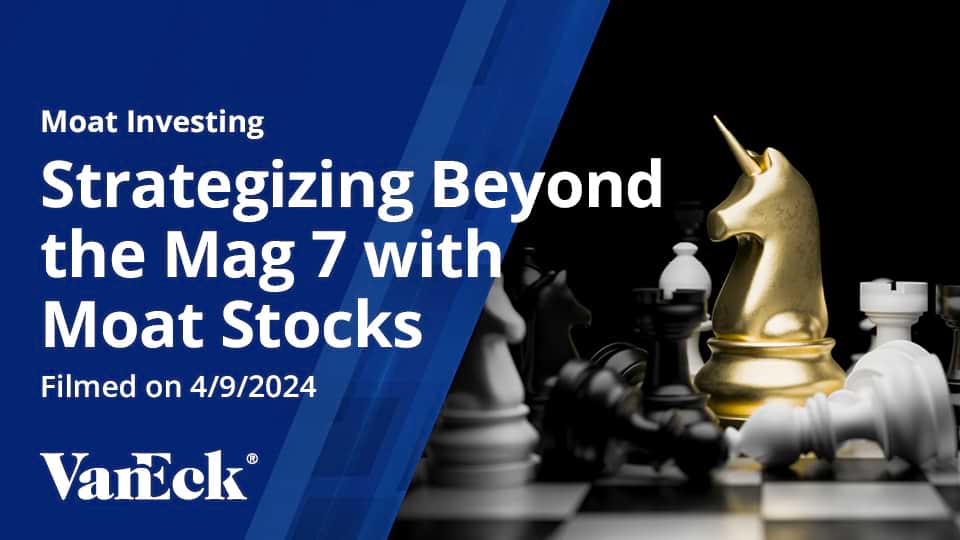The Moat Show Ep. 6: TransUnion with Morningstar's Rajiv Bhatia
January 16, 2024
Watch Time 16:49 MIN
Dive into Transunion's competitive edge and the dynamics of the consumer credit reporting landscape with insights from Rajiv Bhatia, CFA, a seasoned Morningstar Equity Analyst.
On The Moat Show, we uncover the companies with economic moats, one stock at a time, by bringing on analysts from Morningstar to share their in-depth insights with you.
The views and opinions expressed herein are those Rajiv Bhatia of Morningstar as of 12/21/23 and are not intended as financial advice, a recommendation to buy or sell any securities mentioned, or any call to action. Actual future performance of any securities mentioned is unknown. Certain statements may constitute forecasts, projections, or other forward-looking statements which are valid as of the recording date, for illustrative purposes only, subject to change without notice, and do not necessarily reflect those of VanEck or its employees.
CHELSEA: For today's Moat Show episode, we're covering one of the big three consumer credit bureaus, TransUnion. And we have on Rajiv Bhatia, equity analyst at Morningstar. Rajiv, for those unfamiliar with TransUnion, can you provide an overview of the company's pretty long history, how it's evolved and its core business lines today?
RAJIV: Sure. And it's great to join the show. So just so folks are familiar, a consumer credit bureau such as TransUnion is a business that collects credit information about individuals. So, this is primarily a person's borrowing and payment history. So this would include the amount and type of credit a person has and whether the person makes their payments on time. You know, before the large credit bureaus that we have today, you go back 100 years ago, banking was really community based and relationship based. If you wanted a loan, there might be some small local independent credit bureau. But lending decisions really could depend on your community standing. You might have someone in your community who would testify to your character, for example. And as you could imagine, lending decisions, you know, wound up being quite subjective. So TransUnion itself traces its history to the late 1960s when it acquired the credit bureau of Cook County. And that would be Chicago, which was one of the first computerized information systems in the space. Through acquisitions, TransUnion became a formidable national player. And since expanded internationally and across different use cases. If we look at their business today, you know, about 80% of it is U.S. based. Within the U.S. base revenue, there's the kind of the core lending use case. So, you know, think mortgage, think auto, think cars, think personal loans. And then there are other use cases such as tenant screening, employment, government services, marketing. And then you also have and they also have a consumer business as well.
COULTER: Wow, so it sounds like they really do provide a lot of consumer credit here, too. You know, a variety of entities across different sectors. So I guess you kind of mentioned some of the sectors that, you know, sort of buy this data from, agencies like TransUnion. But you get to talk about, you know, what are the what's this data used for it and why are these parties so interested, you know, in this data for these clients?
RAJIV: Yeah. So the base use case is a lender payment credit bureau such as TransUnion to get information to make a credit decision. So, you know, think of mortgage lender, auto lender, card lender making a credit decision. You know, whether someone historically has made their payments on time and how much debt they have outstanding that has strong predictive validity in making a lending decision. However, for lenders, there are other services the credit bureaus provides. So, one would be marketing. You know, think of a credit card company wanting to target a card to say upmarket consumers. Or you could have an auto lender wanting to target the subprime space. Another would be fraud and identity. So if you've applied for a loan, you might have run into what's called a knowledge based authenticator, and that is where you might get prompted with a question such as, okay, which of these addresses have you lived previously, or something like that. And often those questions are sourced from the credit bureaus.
COULTER: That’s interesting. I mean, the lending aspect of is probably what I think of first, but I didn't quite realize that they use it, you know, as far as deep and down as, you know, sort of the prompting of, you know, what address have you learned that, you know, in the past five years and sort of, privacy and protection perspective. So, another question I have is sort of given, you know, the inflationary pressures that we've seen pretty much this entire year. What's been talked about pretty much the last year or two, you know, how is that, you know, sort of impacted on the consumer credit data side of things? You know, have they had to increase the prices of the data that they're providing? And how has that played out within the industry generally?
RAJIV: Yes, I would say historically, their pricing actions, you know, were fairly modest, you know, maybe 1% a year or so. You know, while they do have a wide moat in our view, they are unique in that they have a consortium business model. So their bank customers are also the ones that are supplying them with the data. And large banks tend to be quite sophisticated. In the inflationary environment, they have been able to take more pricing, particularly as fair Isaac, which owns the IP of the FICO score, has increased prices. So, if FICO scores essentially just an overlay on the credit bureau data, so the credit bureaus provide the data input and then Fair Isaac owns the algorithm. And so this is why someone's FICO score changes depending on whether the data source from TransUnion, Equifax or Experian. You know, because FICO scores are based on credit bureau data, they are sold through the credit bureaus. You know, historically, up until 2018, Fair Isaac never took a meaningful price increases as they were content to grow the volume. And, you know, frankly, I think this was a management oversight in my view. However, since then, they've been taking pretty large price increases. And so the credit bureaus have been increasing prices more than Fair Isaac’s to keep their margins. And that has resulted in greater growth dollar profit. So just to kind of put some numbers on it and kind of give an example, you know, looking at 2023 versus 2022, FICO scores on a mortgage kind of went from $0.60 per score to up to $.74 score. So what three scores on a mortgage, because a mortgage will generally have a credit report from all three bureaus, basically one from a $1.80 to about $8 per mortgage and a tri merge report for a mortgage, which includes all three bureaus and three scores. I mean, that may have gone from, say, $50 to $75. And you really saw the impact of this insurance union's most recent quarter. Like mortgage revenue was up 26% despite a 21% decline in volumes.
CHELSEA: Rajiv, can you explain the concept of a moat as used by Morningstar in company and stock analysis? Could you also detail how TransUnion meets the criteria of wide moat rating by outlining its specific competitive advantages?
RAJIV: Sure. So an economic moat refers to a company's durable competitive advantage. So a company with an economic moat can fend off its competitors and get high returns on the capital it deploys. You know, we attribute that moat to a source. So one example would be a cost advantage. If you think about Walmart, say, you know, it has the cost advantages given its large scale advantage. As it relates to TransUnion, TransUnion. Data is critical to loan and underwriting decisions, and the price of its services is negligible relative to the amount of risk. I mean, you just want to ballpark it. I mean, you look at the three main credit bureaus in the U.S., that would be Equifax, Experian and TransUnion. You know, they generate about a billion or so in revenue from credit card lines of business. I mean, today there's just over 1 trillion in U.S. credit card debt outstanding. I mean, if you look at auto loan origination, those are typically over 700 billion per year in the U.S. And auto revenue for all three combined is, you know, probably around 600 million. So relatively negligible relative to the amount of risk. I would say you know, currently it's a pretty stable oligopoly like structure in the industry. You know, we think there are high barriers to entry that's around the business as replicating the databases of leading providers, like a TransUnion would be difficult. I mean, TransUnion customers, you know, which are which are the lenders, they're really more concerned about the breadth and accuracy of the data than the price necessarily. So, for example, you could see a lender may use, you know, one or two credit bureaus, but those bureaus don't have much information on a consumer. You know, that would be what's known in the industry as a as a credit than a file. The lender will then look towards a third bureau. And then the other unique thing about the industry is that the credit bureaus, suppliers are their customers. So they take data from thousands of financial institutions, clean it, aggregated and repackaged it, and so back to them. So that makes it really hard for a new competitor to come in. So over time, we believe the credit bureaus have created a strong, you know, tangible asset with their data sets and the relationships they have with thousands of financial financials and banks.
COULTER: Rajiv, I don't think I talked a little bit about the price action of transgene recently. You know, recently there's been quite a bit of volatility, a lot of that came from sort of a disappointing earnings release in October. You know, we saw the share price drop, you know, almost 40% in just that month alone. And I recall at the time reading your update on TransUnion and you noted sort of the sharp decline as perhaps maybe being an overreaction by the market. And they thought, you know, there might be some value there, there is a valuation opportunity there. But can you talk briefly about sort of how Trans Union has performed in the year and kind of where is the valuation stand today relative to your estimate of fair value?
RAJIV: Yeah, just so our listeners are familiar about what Coulter is talking about: in late October, about two months ago, TransUnion reported their third quarter earnings and there were a bit soft and they were also reported a disappointing fourth quarter outlook. And as a result, the stock dropped in one day 23%. You know, since the company went public in 2015, that was actually their worst single day. So. So just some thoughts there. I would say in general, the market is very jumpy. You know, I've seen stocks when they were you know, they'll be down 4% after they report earnings. And then for some reason they'll finish the day up 4%. So it does feel like in this market environment, the market just sometimes can't make up its mind. That can present an opportunity to thoughtful investors. So TransUnion the stock price, it went from $65 to $50 and then in the following days and weeks kind of hit a low of $42. You know, now the stock is about $68. So it can be pretty volatile. And obviously, if you bought the stock at the low at 42, you would have done really well in just a few months. Yeah, I would say TransUnion, third quarter results. They were clearly a big surprise to the market. Equifax had reported the prior week and they had reported pretty solid core guidance. Yeah, TransUnion’s management, they talked about a weak September. The credit bureaus have a recurring variable revenue model or what you might call an embedded transaction based revenue model. So, yes, they do have long term contracts with their customers, but the amount of revenue they generate is actually based on volumes. So my sense is they just had an air pocket in September which surprised them. And given that they decided to take what's known as a big bath or kitchen sink quarter. Basically if you have a bad quarter, it's like why not make it worse, so you fully reset expectations and then it makes it easier to beat later on in the quarter. They also took a goodwill write down for their U.K. business. They also withdrew their long term guidance. So in March 2022, right before the market went south, they did give guidance of 5 billion of revenue by 2025. Going into the quarter, we felt that was ambitious. You know, before it was true that our model was at 4.6 billion. Yeah. I mean, I would say since then, like a November sentiment on the market improved overall, particularly for financials. So that's helping them. I mean, we still see upside on TransUnion shares. You know, we have a $91 fair value estimate, which is based on our discounted cash flow analysis. You know, we think the market overreacted and we think recession concerns are overblown. You know, looking at transient closest peers, we have Equifax that's just slightly undervalued. And we have Experian roughly fairly value. I mean, TransUnion currently trades at about 19 times forward earnings. That's consistent with the S&P 500 index overall. You know, historically, it's traded like a 20% to 30% premium. So the valuation is definitely cheap relative to its historical average.
CHELSEA: Let's talk more about international expansion efforts, more specifically India. Can you describe what TransUnion's expansion strategy is in India and its expected impact on the company's revenue growth.
RAJIV: Yeah. So about 20% of TransUnion revenue right now is international. About a quarter of that is from India. So India's trend is large international market. But, you know, it's only 5 to 6% of the firm's entire revenue. You know, after India, the U.K., Canada and Latin America are each slightly smaller, even though it is only, you know, 5 to 6% of revenue, I do think it is worth calling out. One reason for that, it is by far trends, unions fastest growing segment, you know, growing 30% plus per year. And it's really showing no signs of slowing down. You know, just given population growth, the size of the market, trends such as the rise of a middle class, we expect it to become more meaningful over time. So over the next five years, we expect continued strong growth. You know, five years from now, we expect a mid to high twenties organic, constant currency revenue growth just given the runway it has there.
COULTER: Great. Well, I mean, you know, beyond some of these sort of more valuation opportunities and growth drivers that all sound great, Alan touched little bit on risk that might potentially come up for a company like TransUnion. You know, there's been, as I mentioned earlier, a lot of interest and a lot of concern about interest rates here in the U.S. and sort of how that might have a delayed effect on the economy. And, you know, even the prospects of a recession, you know, next year on time. So, I want to get your view on, you know, how you think these you know, these might impact the union as well as, you know, you know, any other, you know, potential risks are out there that you're kind of keeping your eye on.
RAJIV: Yeah, so I’ll start with interest rates. I mean, on consumer lending. The biggest impact from higher interest rates is going to be on mortgage. I mean, not only we've seen home purchase volumes decline quite a bit, but refinances have been very soft just given the rise in interest rates. I mean, you still have some, you know, cash out revised, maybe people taking home equity lines of credit. But overall, refis are down quite a bit. So 2023 refi, they're probably looking to be down around 80% versus the 2021 levels. Another thing to consider with interest rate is that TransUnion has a large chunk of variable debt on its balance sheet that it incurred for acquisitions over the year. So in 2023, we forecast interest expense to grow 14% for TransUnion, you know, as interest rates come down. You know, they should get some benefit from an earnings perspective. You certainly could have idiosyncratic risks such as data breaches or regulatory reviews. If you go back to 2017, Equifax had a major data breach, but they subsequently recovered. The credit bureaus. They have a lot of personal data on people, so they're going to be somewhat controversial with the public. You know, you sometimes hear complaints. Those regulatory reviews, such as from the CFPB, those can result in settlements. So that's always a risk to be mindful of. You know, I think as far as the macroeconomic environment and intent to the recession question, I think one key learning is that every recession really is different. So, you know, in a quote unquote typical recession interest rates actually go down and that's kind of good for mortgage refis. On the other hand, if you have a housing led downturn like we saw in 2008 or we have a stagflation area, recession area environment with rising interest rates, you could see mortgage volumes fall during the COVID recession of 2020. Some non-cyclical items do not perform well due to the lockdown. So tenants, green revenues were weak as consumers were locked down and not moving. They had the time, they had a health care business that was weak as consumers delayed elective health care procedures. I would say if you look at TransUnion’s 2029, revenues was about 13% lower than 2007. I mean, the global financial crisis, you know, it was pretty bad. You know, definitely a major banking crisis where banks are really cung back on lending. You know, broadly speaking, in any given year, I would kind of, you know, low single digit organic revenue decline is, you know, a pretty bad scenario. You know, in a bull market, I would expect, you know, maybe 10% ish, maybe a touch about 10% growth per year. So that kind of gives you an outcome, that kind of gives you a view of what we think the Rangers are. You know, in our base case, we kind of expect a mid to high single digit revenue growth.
COULTER: As with any company, there's always some rights of their own boundaries. I think, you know, keep your eye on. But it also sounds like there's really some sort of some good opportunities in terms of growth drivers, you know, with in India and in other, you know, sort of international markets for, you know, going to be like trade union, you know, as sort of as well as, you know, potentially even, you know, a valuation opportunity still, you know, sort of following some of those negative earnings and sort of, you know, earnings reset, as you put it in a way. Again, with that, you know, we're out of time, but I think this has been a very insightful conversation. So thank you, Rajiv, for sharing both your time and your insights here with us today. So we very much appreciate it.
CHELSEA: Thanks, Rajiv.
COULTER: Thank you to all those watching, and see you next time on The Moat Show.
IMPORTANT DISCLOSURE
Please note that VanEck may offer investments products that invest in the asset class(es) or industries included in this video.
The views and opinions expressed are those of the speaker(s) and are current as of the video’s posting date, and are not necessarily those of VanEck or its other employees. Video commentaries are general in nature and should not be construed as investment advice. References to specific securities and their issuers or sectors are for illustrative purposes only. This is not an offer to buy or sell, or a recommendation to buy or sell any of the securities, financial instruments or digital assets mentioned herein. The information presented does not involve the rendering of personalized investment, financial, legal, tax advice, or any call to action. Certain statements contained herein may constitute projections, forecasts and other forward-looking statements, which do not reflect actual results, are for illustrative purposes only, are valid as of the date of this communication, and are subject to change without notice. Actual future performance of any assets or industries mentioned is unknown. Information provided by third party sources are believed to be reliable and have not been independently verified for accuracy or completeness and cannot be guaranteed. VanEck does not guarantee the accuracy of third party data.
All investing is subject to risk, including the possible loss of the money you invest. As with any investment strategy, there is no guarantee that investment objectives will be met and investors may lose money. Diversification does not ensure a profit or protect against a loss in a declining market. Past performance is no guarantee of future results.
No part of this material may be reproduced in any form, or referred to in any other publication, without express written permission of Van Eck Associates Corporation.
© 2024 Van Eck Associates Corporation.
666 Third Avenue, New York, NY 10017.
Related Topics
Related Insights
April 10, 2024



